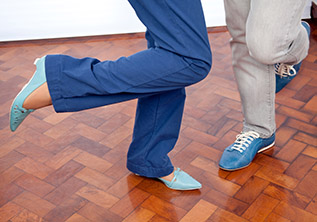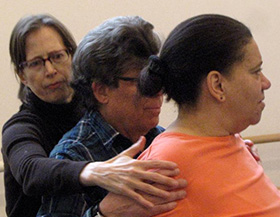As a dancer with decades of professional experience, Pamela Quinn was used to being in the spotlight. But when life handed her “an unexpected blow” in the form a diagnosis of Parkinson’s disease at the age of 42, she retreated from the world of dance, her passion since she was a teenager.
“For anybody to be diagnosed with a serious illness is difficult, but particularly if you’re a dancer… it really takes you aback,” Quinn says. “It was kind of an identity crisis – everything that I had done and was doing was all bound up with movement. I needed to step back and refigure things.”
In confronting the symptoms of Parkinson’s, which can include shaking, slow movement, stiffness and balance issues, Quinn found that she began developing coping strategies inspired by her dance training.
She will share her active approach to living with this neurodegenerative disease in a two-day movement and informational workshop on the Douglass Campus at Rutgers–New Brunswick called “Parkinson’s and Dance: Moving Theory and Practice Forward” October 15 and 16, 2014. The free event features dance classes for people with Parkinson’s led by Quinn and David Leventhal, a teacher-educator on dance and Parkinson’s, as well as discussions and demonstrations for caregivers, health care professionals and students.
“As my body started to fail me in certain ways, I applied my choreographic and improvisation techniques of problem-solving to my body,” Quinn explains. “I thought, ‘These work for me – I wonder if they will work for other people? Maybe I should try to teach.’”
And that’s exactly what Quinn did, creating a program called PD Movement Lab, in collaboration with the Brooklyn Parkinson Group in New York City, to guide people with Parkinson’s through balance and stability activities based on her dance training.
Mason Gross dance students will attend the movement classes in which Quinn will discuss dance and disability, presenting tough questions to young choreographers.“Is dance for everyone?” Quinn asks. “If a person with a disability is in a piece, the [performance] you get is based on their capabilities and their disabilities, and that inevitably informs the piece.”
Quinn will also present issues associated with viewing performers with physical limitations, including the “discomfort of an audience in terms of disability,” she says.
“You might find it quite intriguing [when you read about it],” says Quinn, “but you’re not put off by it because you’re not having to face it or experience it in some visceral way until it’s right before you.”
Mason Gross professor Jeff Friedman, who has danced professionally with Quinn, says that Quinn helps students see themselves as part of a “continuum of people who dance.”
“Students sometimes feel invincible,” Friedman says. “We really challenge them to think about bodies as variables—there are people in the world who dance seriously who don’t have the ‘perfect’ body.”
“What’s so interesting about Pam’s work is that she presents … as if she doesn’t have a disability,” Friedman continues. “And yet she’ll be performing her work and gradually bringing the students into an awareness that this is a person with Parkinson’s.”
Julia Ritter, chair and artistic director of the Dance Department at Mason Gross, is especially committed to expanding Quinn’s work on campus in order to connect with the Parkinson’s population in the area.
“By offering something centrally, people who are not so close to New York City might be able to come and take classes here instead of traveling so far, which is sometimes prohibitive given their physical challenges,” says Ritter.
Ritter says she is also interested in the intersection of art and science, and has invited medical students from Robert Wood Johnson Medical School to participate in the workshop’s “Coping Strategies to Manage Your Parkinson’s” discussion.
Heather Lee, assistant professor in the Department of Family Medicine and Community Health at the medical school, says the event is an opportunity for these future health care professionals to gain “exposure to alternative approaches to working with Parkinson’s patients.”
Lee points out that the arts can be a powerful tool as the medical community interacts with various patient populations.
“We can never predict how healing will be experienced by one patient over another,” Lee says. “Having a broad range of possibilities to suggest to patients is important.”
For Quinn, supporting others with Parkinson’s has eased the initial anxiety about her own diagnosis.
“The gift of giving to other people far overshadowed any discomfort or trepidation that I [felt] about the situation,” Quinn says. “It really is true that helping other people is the best means to helping yourself.”
To register for Parkinson’s and Dance: Moving Theory and Practice Forward, please contact Carol Larkin at carol.larkin@rutgers.edu or 848-932-1345.




